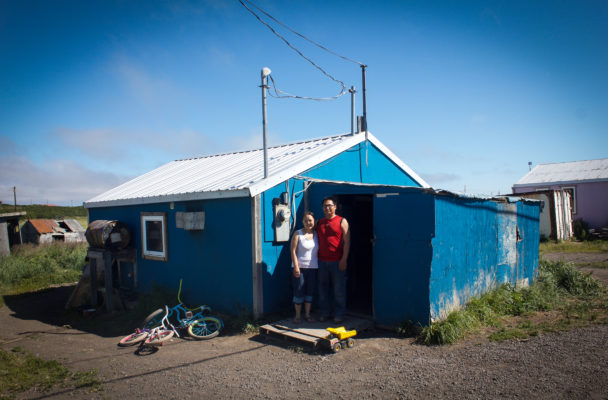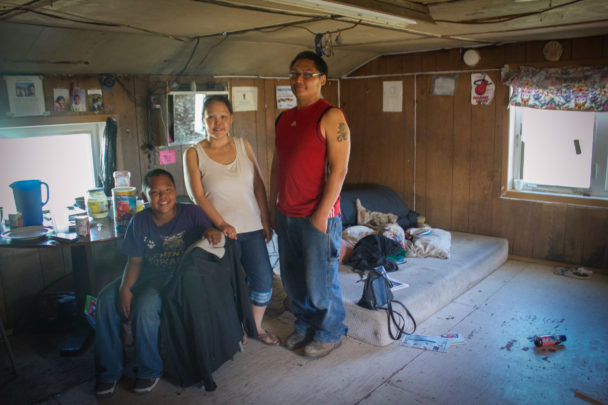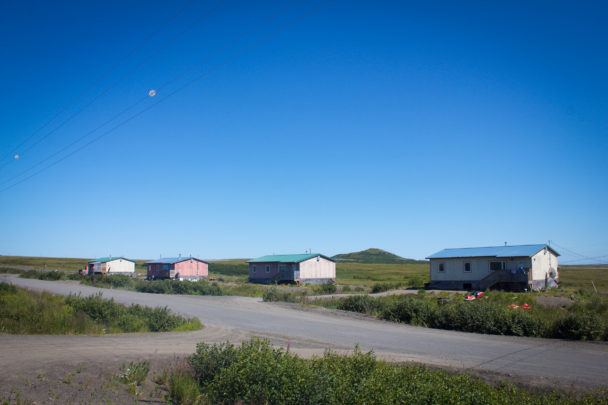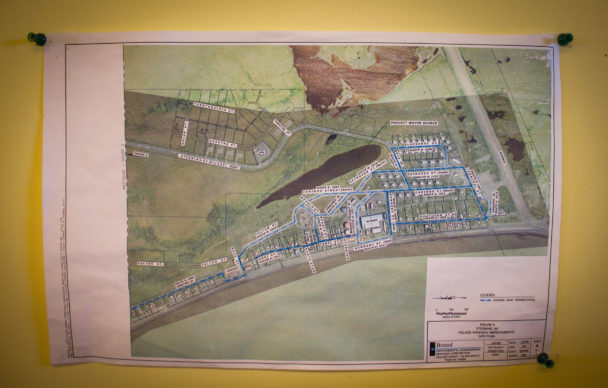In many communities across Western Alaska, populations are rising, but housing has failed to keep up. In the late 1990s the tribal government in Stebbins took control over housing from the regional non-profit.

Minnie Pete and her husband, Bernard Pete, outside their home in Stebbins. (Photo by Emily Russell, KNOM – Nome)
The idea was to speed up the building process, but it’s actually led to stagnation and overcrowding.
Four-wheelers piled high with people kick up dust outside Minnie Pete’s bright blue home. It’s a sunny day in Stebbins and berry season is in full swing.
Pete is usually at work, but right now she’s at home with her five kids. One of them won’t let newcomers inside the house without payment in the form of a hug.
The ceiling sags low and the air is so thick it’s tough to breathe. “Sorry it’s a little messy,” Pete apologizes.
Pete’s home is tiny—just one room, with a mattress on the floor, a TV, a small table and an oven.

“What would you say the length and width is? Twenty by forty [feet]. No rooms [and] no bathroom coverage,” explains Pete.
Stebbins doesn’t have plumbing, so there’s a honey bucket tucked in the corner. In all, eight people live under the same roof, but Pete is grateful that they even have one. Some people say they’d heard about others living in tents and even in the trees.
Cornealius Dan is the Executive Director of the Stebbins Housing Authority. Dan describes the housing crisis in Stebbins as “critical.”
The Stebbins tribe decided to leave the Bering Straits Regional Housing Authority in 1997.
“The main reason being [that] it had been almost 20 to 30 years before Bering Straits Regional Housing Authority came in and put houses in,” Dan explains.
Federally recognized tribes receive funding through the Housing and Urban Development program. The Bering Straits Regional Housing Authority pools that funding and spreads it around the region where needed, like in Stebbins, where it constructed over 40 homes before the tribe decided to leave.

When the tribe took control of their own funding, community members say they were promised five new homes a year, but over the last two decades, the Stebbins Housing Authority built just eight. Cornealius Dan lives in one of those homes with his wife and son.
“It was owned by my mother, and I inherited what we paid for it,” explains Dan.
In the last 20 years, the Stebbins Housing Authority also built nine new apartment units, but only a third of those are occupied. Dan blames maintenance issues and a complicated application process.
“There’s a background check, criminal check, criminal background check, credit check,” explains Dan.
That’s all on top of the 15-page housing application. Tia Katcheak says that was a hurdle her sister couldn’t clear.

“She got an application from the Stebbins Housing Authority and she [doesn’t] even know how to fill it out” Katcheak explains. “It’s really thick, I guess.”
Katcheak and her two sons gave up their home to her sister, who has three kids. Today they all share a bedroom in her parents’ home.
“We tease each other in my mom’s house. We’ll be like, ‘Apartment 1, Apartment 2, Apartment 3, and Apartment 4’—the bedrooms,” Katcheak explains. “So, I’m in number 3.”
Joking aside, Katcheak describes housing in Stebbins as “depressing.”
“Especially in the summer, because everybody wants to stay awake when everybody else has a job at 10 o’clock in the morning, or 8 o’clock in the morning,” Katcheak says.
People in Stebbins are tired and they’re frustrated. The tribe can decide to rejoin the Bering Straits Regional Housing Authority. Regional oversight is more efficient in some ways, as it cuts down on administrative costs and allows for more selective hiring, but even that solution isn’t perfect.
Back inside Minnie Pete’s crowded home, she says she applied for housing before Stebbins took control in the 1990s.
“I was denied because I had too many children,” explains Pete.
With the population of Stebbins steadily rising, Pete’s situation is bound to become more and more common.
Emily Russell is the voice of Alaska morning news as Alaska Public Media’s Morning News Host and Producer.
Originally from the Adirondacks in upstate New York, Emily moved to Alaska in 2012. She skied her way through three winters in Fairbanks, earning her Master’s degree in Northern Studies from UAF.
Emily’s career in radio started in Nome in 2015, reporting for KNOM on everything from subsistence whale harvests to housing shortages in Native villages. She then worked for KCAW in Sitka, finally seeing what all the fuss with Southeast, Alaska was all about.
Back on the road system, Emily is looking forward to driving her Subaru around the region to hike, hunt, fish and pick as many berries as possible. When she’s not talking into the mic in the morning, Emily can be found reporting from the peaks above Anchorage to the rivers around Southcentral.




